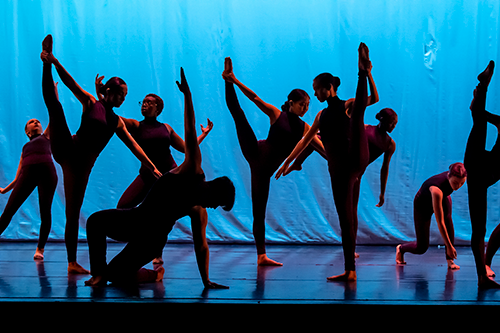Dance
Dance provides the opportunity for students in grades 9-12 to develop aesthetic sensitivity and experience intellectual, physical, emotional and social growth through movement. Students observe, respond, create, and perform using the body as an instrument to communicate feelings, thoughts, and ideas. Through exploring dance concepts, students demonstrate critical thinking skills and core values, as well as develop personal integrity. Dance education fosters positive student interaction and an appreciation for diverse points of view, while establishing strong human bonds which transcend racial, ethnic, and socioeconomic barriers. The sequentially developed program presents a broad cultural and historical perspective, providing unique opportunities for cross-curricular connections.
→ View the Dance performance schedule

Objectives and Artistic Processes
Creating
The process of conceiving and developing new or personal ideas through dance.
Performing
The relating of artistic ideas and choices through interpretation and presentation.
Responding
The synthesis of meaning, context, and process as it connects to dance.
Disciplines
Technique – Classical ballet, modern, jazz
History/Terminology – History, cultural connections, vocabulary/terminology
Composition/Choreography – Creative movement, improvisation, revision, exploration, risk-taking, experimentation, reflection, critiques, research, artistic intent, choreographic forms,
Production/Performance – Lighting design, music editing, areas of the stage, costumes, stage make-up, projection, performance qualities, audience etiquette, kinesthetic/spatial awareness, ensemble/solo, technical skills, leadership qualities, accountability, recall, apply correction, portfolio development
Concepts – Barre procedures, across the floor, floorwork, vertical alignment, turn-out, spotting, head/tail connection, fall and recovery, contract and release, use of breath, dynamics/energies, isolations, opposition, syncopation, flexibility/strength, warm-up/cool down
Grading Standards
- Performance Skills & Practices: Demonstrates artistic behaviors in the rehearsal and performance process: perseverance of task, creative risk-taking, expression in movement, and respect for others and their work.
- Technical Development: Uses best practices and strategies to refine technique and artistry in various styles to ensure the quality of a performance.
- Reflection: Communicates an understanding of aesthetics, concepts, strategies, personal choices, and artistic meaning through the analysis and evaluation of dance.
- Composition & Choreography: Communicates artistic intent and meaning by combining the elements of dance, aesthetic principles, and choreographic forms.
- Idea Development: Draws inspiration from multiple sources and identifies themes to explore in generating a variety of solutions to given dance problems.
- Production & Collaboration: Works effectively with a creative team to achieve a unified vision for a performance and fulfill the artistic intent of the dance work.
Courses
Course descriptions can be found online in the HCPSS Course Catalogs.
High School
- Dance I
- Dance II
- Dance III
- Dance IV
- Junior Dance Company G/T
- Dance Company G/T
- Dance Seminar: Education and Production G/T
- Dance for Athletes
Middle School
- Dance A
- Dance B